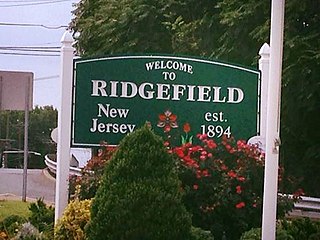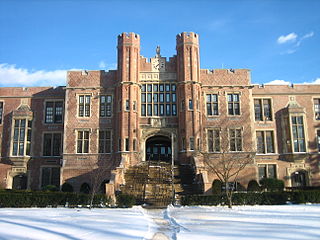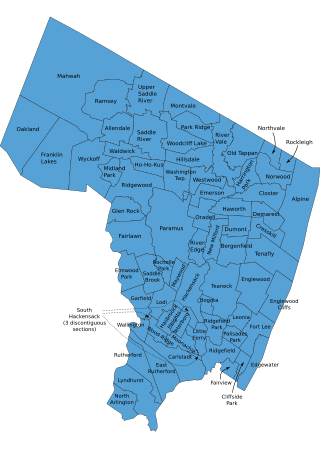
Bergen County is the most populous county in the U.S. state of New Jersey. As of the 2020 United States census, the county's population was 955,732, its highest decennial count ever and an increase of 50,616 (+5.6%) from the 905,116 recorded at the 2010 census, which in turn reflected an increase of 20,998 (2.4%) from the 884,118 counted in the 2000 census. Located in the northeastern corner of New Jersey and its Gateway Region, Bergen County and its many inner suburbs constitute a highly developed part of the New York City metropolitan area, bordering the Hudson River; the George Washington Bridge, which crosses the Hudson, connects Bergen County with Manhattan. The county is part of the North Jersey region of the state.

Bogota is a borough in Bergen County, in the U.S. state of New Jersey. As of the 2020 United States census, the borough's population was 8,778, an increase of 591 (+7.2%) from the 2010 census count of 8,187, which in turn reflected a decline of 62 (−0.8%) from the 8,249 counted in the 2000 census.

Little Ferry is a borough in Bergen County, in the U.S. state of New Jersey. As of the 2020 United States census, the borough's population was 10,987, an increase of 361 (+3.4%) from the 2010 census count of 10,626, which in turn reflected a decline of 174 (−1.6%) from the 10,800 counted in the 2000 census.

Palisades Park is a borough in Bergen County, in the U.S. state of New Jersey. As of the 2020 United States census, the borough's population was 20,292, an increase of 670 (+3.4%) from the 2010 census count of 19,622, which in turn reflected an increase of 2,549 (+14.9%) from the 17,073 counted in the 2000 census.

Ridgefield is a borough in Bergen County, in the U.S. state of New Jersey. As of the 2020 United States census, the borough's population was 11,501, an increase of 469 (+4.3%) from the 2010 census count of 11,032, which in turn reflected an increase of 202 (+1.9%) from the 10,830 counted in the 2000 census.

South Hackensack is a township in Bergen County, in the U.S. state of New Jersey. As of the 2020 United States census, the township's population was 2,701, an increase of 323 (+13.6%) from the 2010 census count of 2,378, which in turn reflected an increase of 129 (+5.7%) from the 2,249 counted in the 2000 census.

Teaneck is a township in Bergen County, in the U.S. state of New Jersey. It is a bedroom community in the New York metropolitan area. As of the 2020 United States census, the township's population was 41,246, an increase of 1,470 (+3.7%) from the 2010 census count of 39,776, which in turn reflected an increase of 516 (+1.3%) from the 39,260 counted in the 2000 census. As of 2020, Teaneck was the second-most populous among the 70 municipalities in Bergen County, behind Hackensack, which had a population of 46,030.

Woodcliff Lake is a borough in Bergen County, in the U.S. state of New Jersey. As of the 2020 United States census, the borough's population was 6,128, an increase of 398 (+6.9%) from the 2010 census count of 5,730, which in turn reflected a decline of 15 (−0.3%) from the 5,745 counted in the 2000 census. Most of the borough mandates a minimum lot size of 22,500 square feet (2,090 m2) for single-family homes, with portions on the borough's east zoned for 15,000 square feet (1,400 m2) and portions of the borough's northwest and southwest zoned for 30,000 square feet (2,800 m2) lots.

Ridgefield Park is a village in Bergen County, in the U.S. state of New Jersey. As of the 2020 United States census, the village's population was 13,224, an increase of 495 (+3.9%) from the 2010 census count of 12,729, which in turn reflected a decline of 144 (−1.1%) from the 12,873 counted in the 2000 census. Of the 564 municipalities in the state, Ridgefield Park is one of only four with a village type of government, though it operates a Walsh Act form of government. Of the four New Jersey villages, Loch Arbour also uses the commission form of government, while Ridgewood operates under the council-manager form, and the Township of South Orange Village operates under a special charter form with many characteristics of village government.

Washington Township is a township in Bergen County, in the U.S. state of New Jersey. As of the 2020 United States census, the township's population was 9,285, an increase of 183 (+2.0%) of the 2010 census count of 9,102, reflecting an increase of 164 (+1.8%) from the 8,938 counted in the 2000 census.
A borough, in the context of local government in the U.S. state of New Jersey, refers to one of five types and one of eleven forms of municipal government.
A township, in the context of New Jersey local government, refers to one of five types and one of eleven forms of municipal government. As a political entity, a township in New Jersey is a full-fledged municipality, on par with any town, city, borough, or village. They collect property taxes and provide services such as maintaining roads, garbage collection, water, sewer, schools, police and fire protection. The Township form of local government is used by 27% of New Jersey municipalities; however, slightly over 50% of the state's population resides within them.

The Caldwells are a group of three municipalities in Essex County, New Jersey, all of which have the word Caldwell in their name. All of these communities are named after the Reverend James Caldwell, a Patriot who played an active role supporting the Continental Army during the American Revolutionary War, most notably his actions at the Battle of Springfield, where he gave the soldiers pages from hymn books to use as wadding for their rifle bullets.
Ridgefield Township was a township that existed in Bergen County, New Jersey. The township was created in 1871, when Hackensack Township was trisected to form Palisades Township in the northernmost third, Englewood Township in the central strip and Ridgefield Township encompassing the southernmost portion, stretching from the Hudson River on the east to the Hackensack River, with Hudson County to the south. Much of the area had been during the colonial area known as the English Neighborhood. As described in the 1882 book, History of Bergen and Passaic counties, New Jersey,
Ridgefield is the first township in Bergen County which the traveler enters in passing up the Palisades. His first impressions are much like those of old Hendrick Hudson in speaking of a wider extent of country: "A very good land to fall in with, and a pleasant land to see." The valley of the Hackensack invited early settlers in the seventeenth century, and the valley of the Overpeck Creek, a navigable arm of the Hackensack, also attracted settlers quite as early in this direction. Sloops and schooners can pass up this creek nearly to the northern boundary of the township. Ridgefield is bounded on the north by Englewood, on the east by the Hudson, on the south by Hudson County, and on the west by the Hackensack River. The southern boundary is less than two miles in extent, and the northern less than four, and the length of the township from north to south does not exceed four miles. Bellman's Creek, forming part of the southern boundary, the Hackensack, the Overpeck, the Hudson, with more than a dozen other smaller streams and rivulets, bountifully supply the whole township with water. From the western border of the Palisades the land descends to the Overpeck, forming a most beautiful valley, with the land again rising to a high ridge midway between the Overpeck and the Hackensack. From this long ridge, extending far to the north beyond this township, it took its name of Ridgefield.
The New York, Susquehanna and Western, formerly the Midland Railroad, the Jersey City and Albany Railroad, and the Northern Railway of New Jersey—all running northward through the township— afford ample railroad accommodations. The Susquehanna enters the township at Bellman's Creek, and the Northern at about one hundred feet south of the creek, and at a point north and east of the Susquehanna. The Albany road in this locality is not yet constructed, diverging at present from the track of the Susquehanna between Little Ferry and Bogota stations. It has, however, an independent line projected and now under construction to New York City.
Early Settlements. Ridgefield embraces the earliest settlements in the ancient township of Hackensack, antedating even the organization of that township in 1693, and of the county of Bergen in 1675. There seems to have been no town or village compactly built, like the village of Bergen, but there were settlements both of Dutch and English in and about what was subsequently known as English Neighborhood prior to 1675. The Westervelts, the Zimcrmans, the Bantas, and the Blauvelts, all coming from Holland, settled in the middle of the seventeenth century in that locality. The ancestors of Jacob P. Westervelt, now of Hackensack Village, with himself, were born in English Neighborhood. His father was born there in 1776, and was the son of Christopher Westervelt, who was born there certainly as early as 1690, and he was the son of the original ancestor of this family, who came from Holland and settled on Overpeck Creek, within the present limits of Ridgefield township, probably about 1670.
Palisades Township was a township that existed in Bergen County, New Jersey, United States. The township was in existence from 1871 to 1922.

Boroughitis was the creation in the 1890s, usually by referendum, of large numbers of small boroughs in the U.S. state of New Jersey, particularly in Bergen County. Attempts by the New Jersey Legislature to reform local government and school systems led to the breakup of most of Bergen County's townships into small boroughs, which still balkanize the state's political map. This occurred following the development of commuter suburbs in New Jersey, residents of which wanted more government services, whereas the long-time rural population feared the increases in taxation that would result.
Overpeck Township was a township that existed in Bergen County, New Jersey, United States, from 1897 to 1938.
The Ridgefield Park Public Schools is a comprehensive community public school district that serves students in pre-kindergarten through twelfth grade from the Village of Ridgefield Park, in Bergen County, in the U.S. state of New Jersey.
Local government in New Jersey is composed of counties and municipalities. Local jurisdictions in New Jersey differ from those in some other states because every square foot of the state is part of exactly one municipality; each of the 564 municipalities is in exactly one county; and each of the 21 counties has more than one municipality. New Jersey has no independent cities, or consolidated city-counties.
The English Neighborhood was the colonial-era name for the towns in eastern Bergen County, New Jersey, along the Hudson Palisades between the Hudson River and the Hackensack River, particularly around its main tributary, Overpeck Creek. The region had been part of the Dutch New Netherland colony of Bergen, whose main town was located at Bergen Square in modern Jersey City. The name refers to the geography of the region, bergen being the Dutch word for hills. Earlier attempts at settlement at Achter Col and Vriessendael had been compromised in conflicts with the precolonial population, bands of the Lenape known by their exonyms, the Hackensacks and the Tappans.











